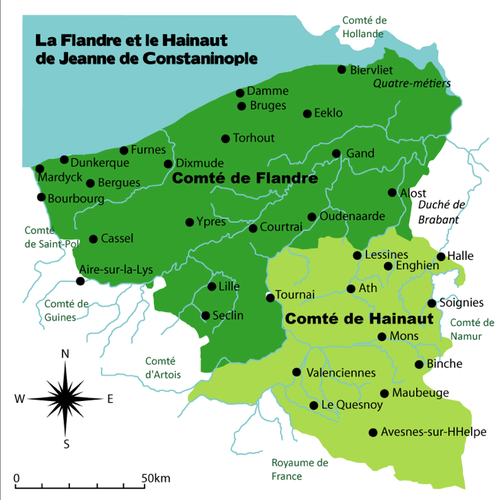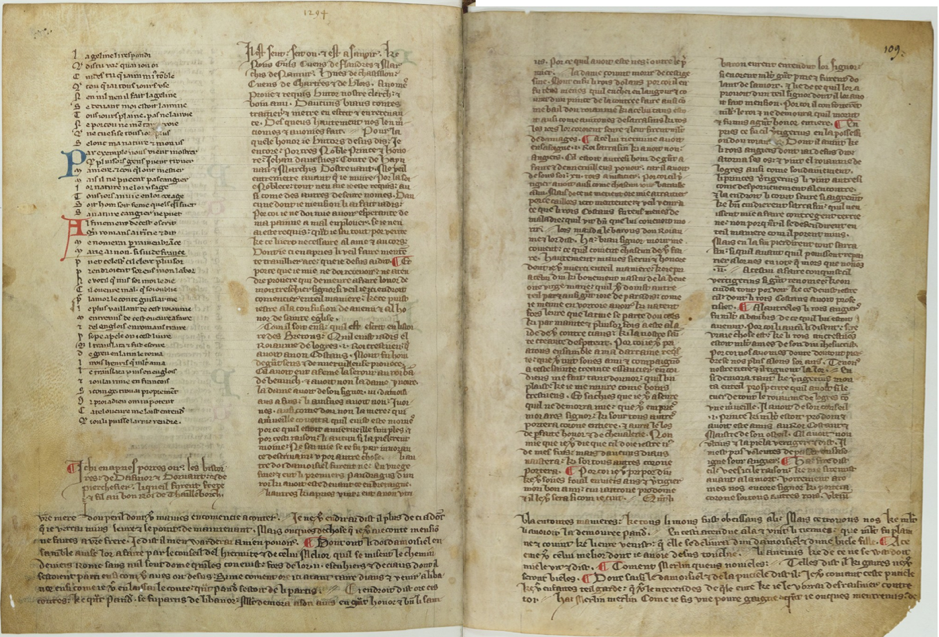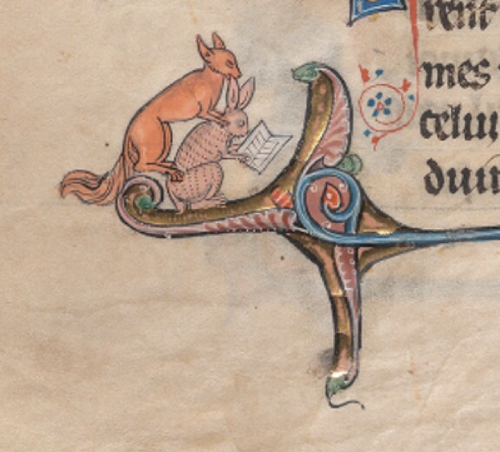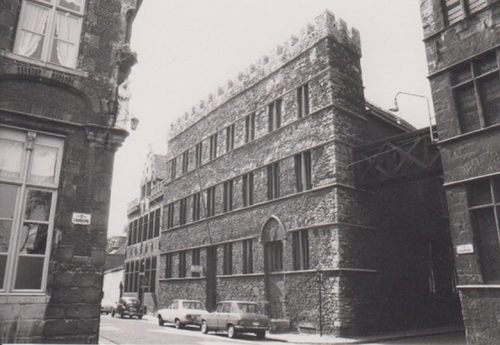Thinking about French in Flanders
David Murray is a post-doctoral researcher at Utrecht University, where he is part of the ‘Multilingual Dynamics of Medieval Flanders, c.1200-c.1500’ project, funded by the NWO.
The map of the medieval Francophone world has expanded a good deal in recent decades. The French of England has been joined by Frenches of Italy, Outremer, and most recently those of Wales and Ireland. Attending to the meetings between French and other languages – whatever their relative status on the ground – and to the evolving social and cultural baggage of French in more or less liminal spaces, recent scholarship has encouraged an ever more-nuanced appreciation of the linguistic geography of the Middle Ages.
Somewhere in the middle of all this is Flanders, a region in which French was (and indeed still is) a part of the furniture, even if its relationship with the colour scheme has changed over time. It is perhaps the Cinderella of the ‘French outside France’ trend. It is always present: TVOF's case study, the Histoire ancienne jusqu’à César, was written for Roger IV (d. 1230), castellan of Lille in la Flandre gallicante, and Flanders also played a major part in TVOF’s predecessor MFLCOF. And yet the substantial contribution to literature in French traceable to the County of Flanders has not enjoyed comprehensive treatment on its own terms. The ‘Multilingual Dynamics of Medieval Flanders’ project, started in Utrecht in 2019, aims to address some of the issues that have hindered such a treatment in the coming years. What follows is a brief sketch of some of the stakes of working with French-language literature in medieval Flanders.
Drawing a line?

Flanders and Hainaut under Countess Jeanne of Constantinople (r. 1200-1244). Source: Wikimedia Commons.
Most history, literary or otherwise, is at a certain point a question of geography. The Counts of Flanders ruled, as occasionally unwilling vassals of the French Crown, over a highly urbanized and economically powerful region that straddled the frontier between the Francophone and Dutch-speaking areas. It is characteristic of its position betwixt and between, though, that one more rural corner of eastern Flanders, around Aalst, was part of the Holy Roman Empire. Another exterior anchor was Tournai – effectively an ‘island’ of French royal influence, sandwiched between Flanders and Hainaut – whose bishop held sway over all of Flanders. But not all major bonds took strictly institutional forms: the wool trade with East Anglia was so centrally important to the Flemish economy that it sometimes, most notably in the fourteenth century, ranked alongside more formal bonds of fidelity.
The ties of medieval dynasties also make it difficult to determine the limits of ‘Flanders’. This can be seen vividly in the late thirteenth-century manuscript Paris, BnF, fr. 1446. The composite manuscript demonstrates well how, even when one attempts to focus exclusively on the counts’ literary patronage, the tight links between Flanders, Hainaut, and the Picard nobility make it difficult to isolate Flanders. The texts in the first section of fr. 1446 (ff. 1–114) originate around count Gui de Dampierre (r. 1278–1305). The first item is an amalgamation of the fourth and the fifth continuations of the prose Roman des sept sages, the Pelyamenus and Kanor. The Kanor was dedicated to Hugues II de Chatillon, count of St. Pol – just to the south of Flanders – and son-in-law to Gui de Dampierre, who was himself the patron of the third and most extensive Sept sages continuation, the Roman de Cassiodorus. These are followed by the beast-epic, the Couronnement de Renart. It takes as its starting point the early death of ‘le bon comte Guillaume’, Gui’s elder brother, in 1253. Next is Marie de France’s Fables, cleverly sewn together with the Couronnement by the scribe, who profits from the fact that Marie’s text was also dedicated to a count Guillaume.
However, what is perhaps most striking about the manuscript’s first section is a slightly later addition: the possibly autograph copy of Baudouin Butor’s four versions of the prologue and opening of an Arthurian romance, the Roman des fils du roi Constant.

Paris, BnF, fr. 1446, ff. 108v-109r, showing the end of Marie de France’s Fables (va), and the beginning of Baudouin Butor’s first draft (vb). In the lower margin is part of Butor’s second draft of his Merlin romance. Source: Gallica
Baudouin says he was writing at the behest of Gui de Dampierre and Hugues de Chatillon. But while they encouraged the work, Baudouin dedicates it to Gui’s Hainauter half-brother and sometime claimant to Flanders, Jean d’Avesnes, who eventually succeeded Marguerite de Constantinople as Count of Hainaut. This Hainaut connection was later strengthened adding dozens of dits to fr. 1446 by Marguerite’s Hainauter protégés, Baudouin and Jean de Condé (ff. 115r–210r). Even when one tries to limit oneself to the literary activities of the Flemish counts themselves, then, the horizontal connections of the aristocracy can often militate against any attempt to focus on the County alone.
Whose French is it anyway?
A further complication in focusing on the county of Flanders is, of course, the geography of medieval French. It is an experience well-known to anyone who has ever opened a manuscript catalogue: you are excited to track down your witness, and turn to the right page, only to be confronted with the rather bland ‘Picard’. As Serge Lusignan among others has demonstrated, though, rather than a localized linguistic form, this label hides a carefully observed scripta. Used not only in the region we now know as Picardy, but in fact from the Oise river north, its reach spread far beyond the areas in which French was a first language, across Flanders and all the way to the County of Holland. As such, linguistic markers which might help inform closer attention to any area of the Picard zone – also including the Latin East – are not so forthcoming as one might hope.
This said, it is also important to consider the value of political and linguistic identity. There are, for example, many instances of users of ‘Picard’ French calling their own linguistic form roumans to distinguish it from Central French, which they called françois. Picard, by contrast, a rather derogatory term based on Middle Dutch piek (the long sharpened stick carried by foot-soldiers), seems to have gained currency among Parisian students in the earlier thirteenth century (Lusignan, 95–103). Clearly the baggage of linguistic choice was open to interpretation by both users themselves and outsiders. Moreover, any attempt to align Flanders and any form of French is historically and socially contingent: count Louis de Male (r. 1346–1384), introduced Central French into his chancery, a state of affairs that continued under the Burgundians, while Picard continued to hold sway in civic documentation. Multilingualism in Flanders thus needs to account for the meaning of lower-level choices within the palette of possible Frenches.
The languages of the fox
Even if it is the French of Flanders that is underserved, however, the literary history of Flanders requires us to go beyond linguistic frontiers. For instance, the Couronnement de Renart, an animal allegory of bad goverment centred on the wily fox, sits not only alongside in the Dampierres’ Francophone patronage, but also the nearly contemporary Middle Dutch Vanden vos Reynaerde. Composed by a mysterious Willem, perhaps one of Marguerite of Constantinople’s clerks (Van Daele 2005), it points to significant intermeshing of literary creativity across the linguistic frontier.
An even greater challenge to the historical tendency to perceive literary history as a centrifugal expansion is the evidence of French-speaking areas as the reception area for cultural productions in Dutch. Staying with foxes, for instance, a clutch of manuscripts produced for the comital family adopt episodes from the Reynaert story known only from the Dutch tradition. Reynaert the fox teaches Cuwaert the hare to read or sing not only in Gui de Dampierre’s psalter (Brussels, KBR, MS. 10,607, f. 86r), but also in a luxurious copy of the Lancelot-Graal Cycle made for his son Guillaume de Termonde.
Moreover, the fascination of the fox Reynaert was not limited to the vernacular. A version in Latin hexameters of the Dutch Vanden vos Reynaerde was composed for another of Gui de Dampierre’s sons, Jean. Installed as provost of St. Donatus in Bruges, Jean was presented with the work by Balduinus Iuvenis, perhaps a monk at the nearby Cistercian abbey Ter Doest. Pulling together elements of what have often been conceived of as individual linguistic literary traditions is thus a challenge as well as a chance to illuminate a complex multilingual literary scene.

Reynaert and Cuwaert in Guillaume de Termonde’s Lancelot-Graal. New Haven, CT, Beinecke Rare Books Library, MS. 229, f. 133v (detail). Northern French? 1280s. Source: Beinecke Digital Collections
Mout sont vallant cil de Gant
Stepping back from the medieval, these linguistic and cultural circumstances continue to be live wires. During talks about the formation of the new Flemish government in late summer 2019, the largest party, the conservative N-VA, proposed the creation of an official canon of Flemish culture and history for use in schools and classes for immigrants.

‘De Kleine Sikkel’ on Nederpolder in Ghent, one of many surviving medieval merchants’ houses, known as steenen (lit. ‘stones’). Home to the Sikkel family from the fourteenth century, the building includes thirteenth-century elements and was renovated in 2016. Source: Agentschap Onroerend Erfgoed
Although it was not explicit, the emphasis on the Dutch language elsewhere in the party’s literature gave reason to suspect a rather monolingual canon. This kind of perspective on the past, however, would ill account for one of the most remarkable windows into the mercantile families who played such an important part in the makings of Flanders.
‘Mout sont vallant cil de Gant’ (‘How magnificent are the people of Ghent’) is a short motet, or multiple-part musical composition, from the mid-thirteenth century. Its highest voice praises the burghers of Ghent, principal city in Flanders and seat of the Counts. The other two voices go into greater detail: the motetus gives a vignette of a January lunch of fattened capon at a smokeless hearth, followed perhaps by a game of chess. Meanwhile, the tenor given in one manuscript (Wolfenbüttel, Herzog August Bibliothek, MS. Guelf. 1099 Helmst., ff. 212v–13r) nods to the origins of the city’s wealth in far-reaching trade networks: ‘Par verité j’ai esprové que vin rinois passent françois et toux vins aucourrois’ (‘Truly, I have found that Rhenish wines are better than French ones and anything from Auxerre’). The fact that this window into the lives of Ghent’s burghers takes the form of a song in French is not only a reminder of the vital place of French in a supposedly Dutch-speaking city, but also how the Low Countries’ distinctive social structures informed language use and the literature produced and consumed there. While in other parts of the Germanic world it might be enough to say that French was an ornament reserved for the nobility, so often a strong gravitational force in literary history (and in this respect I must also plead guilty), this is clearly not the case in Flanders, and so recalibration is necessary.
When the current Flemish Minister President, Jan Jambon, announced his government’s programme, he closed his oration with a nod to the motto of the ne plus ultra of fifteenth-century Flemish patricians, Lodewijk van Gruuthuse. A native of Bruges, Gruuthuse was Burgundian stadhouder of Holland, friend to Edward IV of England, and patron of exquisite manuscripts of medieval French literature, as well as probable owner of the most important collection of Middle Dutch song (pictured). His motto is, of course, in French. Plus est en vous. There is indeed very much more left in Medieval Flanders.

The Hague, Koninklijke Bibliotheek, MS. KW 79 K 10 (The ‘Gruuthuse manuscript’), f. 2, detail (Bruges, c. 1400). Reproduced with permission from the Koninklijke Bibliotheek. Source: KB
Further Reading
Olivier Collet, ‘Littérature, histoire, pouvoir et mécénat: La cour de Flandre au XIIIe siècle’, Médiévales, 38, (2000), 87–110.
Willy van Hoecke, ‘De letterkunde in de Franse volkstaal tot omstreeks 1384’, in Algemene Geschiedenis der Nederlanden, 15 vols (Haarlem: Fibula-Van Dishoeck, 1982), III, Middeleeuwen, pp. 379–92, pp. 457–58 and p. 477.
Serge Lusignan, Essai d’histoire sociolinguistique: Le français picard au Moyen-Âge, Recherches littéraires médiévales, 13 (Paris: Classiques Garnier, 2012).
Johan Oosterman, ‘Franse en Nederlandse letterkunde in middeleeuws Vlaanderen’, in Literaire bruggenbouwers tussen Nederland en Frankrijk: Receptie, vertaling en cultuuroverdracht sinds de Middeleeuwen, ed. Maaike Koffeman et al (Amsterdam: Amsterdam University Press, 2017), pp. 29–47.
Remco Sleiderink, ‘From Francophile to Francophobe: The Changing Attitude of Medieval Dutch Authors towards French Literature’, in Medieval Multilingualism: The Francophone Worlds and its Neighbours, Medieval Texts and Cultures of Northern Europe, 20 (Turnhout: Brepols, 2010), pp. 127–44.
Mary Stanger, ‘Literary Patronage at the medieval Court of Flanders’, French Studies, 11 (1957), 214–29.
Rik Van Daele, ‘De Robotfoto van de Reynaert-Dichter: Puzzelen met overgeleverde wrakstukken’, in Maar er is meer: Avontuurlijk lezen in de epiek van de Lage Landen: Studies voor Jozef D. Janssens, ed. Remco Sleiderink et al (Leuve: Davidsfonds, 2005), pp. 193-215.